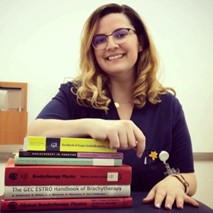ESTRO 2025 Congress Report
By the gynaecology focus group
The gynae track at ESTRO 2025, which was curated by the ESTRO gynaecology focus group, delivered a forward-thinking programme that fell at the intersection of clinical care, science, and technology. From a physicist’s perspective, the sessions underscored the growing importance of physics-driven solutions—from imaging and dose modelling to automation and planning precision—in shaping modern gynaecological radiotherapy.
The opening panel, Shaping the future of brachytherapy, addressed structural barriers to broader implementation, many of which implicate the physicist’s role. While clinical education and mentorship were emphasised, speakers called for physicists to be more visible as educators and system-level enablers. The complexity of applicator-based high-dose-rate (HDR) techniques, spatial accuracy in dose delivery, and imaging-planning integration all rely on strong physics input. This factor is often under-recognised in training pathways and departmental structures.
Panellists argued that technical complexity was a strength, not a weakness—provided that structured training and quality assurance (QA) were in place. There were calls to expand the GEC-ESTRO fellowship to include physics tracks and to develop mentorship frameworks that enable early-career physicists to gain competence in interventional workflows. Physics contributions to dose-constraint design, applicator optimisation, in-vivo verification, and image registration were consistently recognised, particularly in discussions of patient co-creation and multidisciplinary collaboration.
This need for physics-led innovation was further explored in the symposium on Dose accumulation in brachytherapy, which is one of the field’s most pressing challenges. The limitations of basic dose-volume histogram summation methods are well-known, especially in cervical cancer, in which anatomical deformation and inter-fraction variability undermine assumptions of consistency. In the session, speakers emphasised the need to move beyond theoretical models toward robust clinical implementation of deformable image registration (DIR), dose warping, and voxel-wise summation.
Speakers presented a nuanced view of current DIR tools. While voxel-based dose accumulation offers promise for biologically guided planning and prediction modelling, today’s DIR platforms often struggle—particularly when registering across modalities or in the presence of applicators. The lack of standardised QA metrics and the computational demands of high-fidelity deformation remain key bottlenecks. The message was clear: physicists are central to solving these challenges through algorithm development, validation, and integration with planning systems. A skin brachytherapy case study demonstrated how structure-guided DIR could be used to improve spatial and dosimetric consistency significantly over standard algorithms, especially in deformable targets.
Throughout the congress, the physicist’s expanding role in translational innovation was showcased. The symposium on Interventional radioimmunotherapy explored the six Rs of radiobiology (radiosensitivity, repair, repopulation, redistribution, reoxygenation and reactivation of the anti-tumour immune response) in the context of brachytherapy, emphasising its potential as an immunomodulatory modality. With its HDR, spatial heterogeneity, and tissue-sparing properties, brachytherapy may play a unique role in immunogenic cell death. For physicists, this opens new domains—adapting dose models to predict immune response, simulating partial-volume effects, and optimising delivery strategies that enhance immunogenicity while minimising toxicity.
Discussions of trials such as KEYNOTE-A18 highlighted the logistical and technical challenges of combining checkpoint inhibitors with chemoradiotherapy and brachytherapy. Physicists will be crucial in harmonising dose escalation protocols, documenting cumulative biologically effective doses, and ensuring that planning systems accommodate immunological modelling. Incorporation of immune endpoints into dosimetry research represents a new frontier for physics-led innovation.
In Proffered Papers and Poster sessions, technical research was prominently featured. Physics-led studies were focused on Monte Carlo dose verification, radiomics for tumour heterogeneity, organs-at-risk auto-contouring, and robust optimisation of interstitial needle configurations. Tools powered by artificial intelligence for plan adaptation—including deformable structure propagation and automated applicator reconstruction—demonstrated that automation is becoming a pathway to standardisation and reduced variability, not just efficiency.
Reirradiation for pelvic recurrences was another domain in which it was shown that physics is critical. Sessions on Salvage brachytherapy emphasised the need for accurate prior-dose reconstruction, imaging fusion, and anatomical tracking. These cases are among the most technically demanding, especially when prior data regarding external beam radiotherapy lacks deformable planning structures. Applicator placement in scarred anatomy introduces uncertainties in both target definition and dose distribution. Presenters stressed the importance of physicist-led pre-planning and modelling of the equivalent dose in 2Gy fractions to ensure treatment safety and efficacy.
Even clinical debates—such as those on T2N1M0 cervical cancer management—implicitly reflected the physicist’s behind-the-scenes role in enabling dose escalation or modulation in both definitive and adjuvant settings. Similarly, the Joint European Society of Gynaecological Oncology, European Society of Pathology and ESTRO symposium on endometrial cancer emphasised the need for coordinated implementation of risk-adapted strategies, including transitions from 3D-conformal to intensity modulated radiotherapy and brachytherapy, in which close clinician-physicist collaboration is essential.
The symposium on Planning in the presence of previous dose and reirradiation reinforced the need for improved integration of adaptive workflows and dose-tracking systems. From a physicist’s standpoint, this includes linking historical plans, ensuring consistent image datasets, and quantifying dose across timepoints and modalities in biologically meaningful terms.
In summary, the ESTRO 2025 gynae track made clear that the future of gynaecological radiotherapy—especially brachytherapy—relies on continued leadership from medical physicists. As planning becomes more adaptive, imaging more integral, and biological modelling more sophisticated, physicists are no longer just technical stewards—they are the architects of precision.
The tools we physicists build and the standards we uphold will define the quality, safety, and accessibility of gynaecological radiotherapy in the decades to come.

Diana-Cristina Pop, medical physicist
Institute of Oncology “Prof.Dr. Ion Chiricuta” Cluj-Napoca, Romania
pop.diana@iocn.ro
LinkedIn: Pop Diana-Cristina
Instagram: patcasdiana